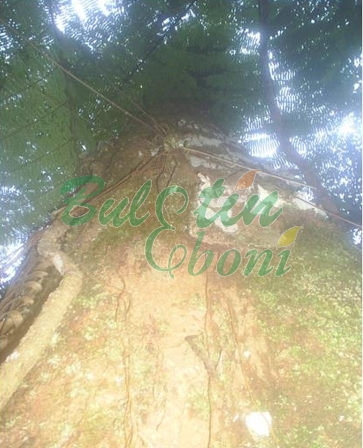
Properties of Wood and Nuts of Makadamia (Macadamia hildebrandii Steen) from Sulawesi
Abstract
Keywords
Full Text:
PDFReferences
Akhbar, Nuryanti, S., & Naharuddin. (2020). Spatial distribution and habitat characteristics of Macadamia hildebrandii in the sintuwu maroso protection forest, Central Sulawesi, Indonesia. Biodiversitas, 21(2), 770–778. http://doi.org/10.13057/biodiv/d210245
Asdar, M. (2011). Anatomi Kayu Macadamia hildebrandii van Slooten. In Prosiding Seminar Nasional Masyarakat Peneliti Kayu Indonesia (MAPEKI) XIV (pp. 66–71). Yogyakarta.
Asdar, M., Aksar, M., Palalunan, Hajar, & Suarman, A. (2009). Sifat Dasar Kayu Kates (Macadamia hildebrandii Van Slooten). Laporan Hasil Penelitian. Balai Penelitian Kehutanan Makassar. Makassar.
Badan Standardisasi Nasional. (1989). Syarat Sifat Fisik dan Mekanik Kayu untuk Mebel (SNI 01-060). Jakarta: Badan Standardisasi Nasional.
Badan Standardisasi Nasional. (1999). Pengawetan Kayu Untuk Perumahan dan Gedung (SNI 03-501). Jakarta: Badan Standardisasi Nasional.
Culmsee, H., & Pitopang, R. (2009). Tree diversity in sub-montane and lower montane primary rain forests in central sulawesi. Blumea: Journal of Plant Taxonomy and Plant Geography, 54(1–3), 119–123. http://doi.org/10.3767/000651909X475473
Departemen Pertanian. (1976). Vademecum Kehutanan Indonesia. Jakarta: Direktorat Jenderal Kehutanan, Departemen Pertanian.
FAO. (1985). Industrial Charcoal Making. (FAO Forest). Rome: FAO.
Forest Product Laboratory. (1999). Wood Handbook - Wood as an Engineering Material. Madison WI: U.S. Department of Agriculture, Forest Service, Forest Products Laboratory.
Ginoga, B., Seran, D., Lempang, M., & Kiding Allo, M. (1987). Pertumbuhan dan sifat kayu tomaku (Macadamia hildebrandii V.St.). Jurnal Penelitian Kehutanan Balai Penelitian Kehutanan Ujung Pandang, 1(1), 1–8.
Kementerian LHK. (2019). Pulihkan Lahan Kritis di Hulu DAS , KLHK Ajak Tanam Pohon Kacang Termahal di Dunia. Siaran Pers.No. SP.485/HUMAS/PP/HMS.3/12/ 2019. Jakarta. Retrieved from https://ppid.menlhk.go.id/siaran_pers/browse/2226
Lukman, A. H., & Silitonga, T. (1989). Perubahan Komponen Kimia Buah Makadamia (Macadamia hildebrandii Steen) Selama Penyimpanan. Jurnal Penelitian Hasil Hutan, 6(2), 113–116.
Martawijaya, A., Kartasujana, I., Kadir, K., & Prawira, S. A. (1981). Atlas Kayu Indonesia (Volume I). Bogor: Balai Penelitian Hasil Hutan. Badan Litbang Pertanian.
McDonald, J. A., & Ismail, R. (1995). Harvard University Herbaria. Harvard Papers in Botany, 1(7), 121–131.
Metcalfe, C. R., & Chalk, L. (1950). Anatomy of Dicotyledons (Volume II). Oxford: Clorendon Press.
Metungku, A., Labiro, E., & Rahmawati. (2019). Komposisi Jenis-Jenis Pakan Lebah Madu Hutan (Apis Dorsata) di Kawasan Hutan Lindung Desa Panjoka Kecamatan Pamona Utara Kabupaten Poso Sulawesi Tengah. Warta Rimba, 7(1), 7–16.
Oey, D. S. (1990). Berat jenis dari jenis-jenis kayu Indonesia dan pengertian bertanya kayu untuk keperluan praktek (Pengumuman). Bogor: Pusat Penelitian dan Pengembangan Hasil Hutan.
Pantjawidjaja, S. (2010). Suatu Prospek Baru dari Maladewata Sebagai Sumber Energi Pakan Unggas dan Pelestarian Lingkungan. In Prosiding Seminar Nasional Teknologi Peternakan dan Veteriner. Bogor: Pusat Litbang Peternakan.
Pitopang, R. (2012). Impact of forest disturbance on the structure and composition of vegetation in tropical rainforest of Central Sulawesi, Indonesia. Biodiversitas, Journal of Biological Diversity, 13(4), 178–189. http://doi.org/10.13057/biodiv/d130403
Pitopang, R., & Ihsan, M. (2014). Biodiversitas Tumbuhan di Cagar Alam Morowali Sulawesi Tengah Indonesia. Oniline Jurnal of Natural Science, 3(3), 287–296.
Rahayu, S., Widayati, W., & Indriasary, A. (2018). Pemetaan Komponen Ekosistem Untuk Pengembangan Edu-Ekowisata ( Studi Kasus : Kebun Raya Universitas Halu Oleo ). Jurnal Geografi Aplikasi dan Teknologi, 2(1), 33–40.
Shmulsky, R., & Jones, P. D. (2011). Forest Products and Wood Science An Introduction. Journal of Chemical Information and Modeling (Sixth Edit, Vol. 53). Iowa: John Wiley & Sons Ltd.
Siagian, R. M., & Silitonga, T. (1988). Percobaan Pembuatan Pulp Sulfat dari Kayu Makadamia (Macadamia hildebrandii Van Steen). Jurnal Penelitian Hasil Hutan, 5(4), 192–195.
Tandi, E. J. (2013). Pengaruh Perlakuan Urea Terhadap Kadar Tanin Biji Makadamia (Macadamia hildebrandii). Buletin Nutrisi dan Makanan Ternak, 9(1), 41–46.
van Steenis, M. J., & Kruseman. (1956). Flora Malesiana, Series I, Vol. 5. Jakarta: Noordhoff-Kolff, N.V.
Weston, P. H., & Barker, N. P. (2006). A new suprageneric classification of the Proteaceae , with an annotated checklist of genera. Telopea, 11(3), 314–344.
Whitmore, T. C., Tantra, I. G. M., & Sutisna, U. (1989). Tree flora of Indonesia check list for Sulawesi. Bogor: Forest Research and Development Centre.
Whitten, T., Mustafa, M., & Henderson, G. S. (2002). The Ecology of Indonesia Series (Volume IV.). Hongkong: Periplus edition (HK) Ltd.
Yunianti, A. D. (2006). Stem and Branch Physical Properties of Macadamia Wood. Perennial, 2(1), 16–20.
Zobel, B. ., & van Buijtenen, J. P. (1989). Wood Variation, Its Causes and Control. Berlin: Springer-Verlag.
DOI: https://doi.org/10.20886/buleboni.5763
Refbacks
- There are currently no refbacks.
Copyright (c) 2020 Buletin Eboni

This work is licensed under a Creative Commons Attribution-NonCommercial-ShareAlike 4.0 International License.
Indexed by:
 BULETIN EBONI
BULETIN EBONI




 buletin_eboni@balithutmakassar.org
buletin_eboni@balithutmakassar.org